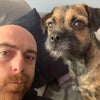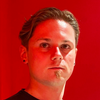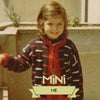The Memorial to the Murdered Jews of Europe (German: Denkmal für die ermordeten Juden Europas), also known as the Holocaust Memorial (German: Holocaust-Mahnmal), is a memorial in Berlin to the Jewish victims and other victims of the Holocaust, designed by architect Peter Eisenman and engineer Buro Happold. It consists of a 19,000 square meter (4.7 acre) site covered with 2,711 concrete slabs or "stelae", arranged in a grid pattern on a sloping field. It also includes statues of non-Jewish victims of the Holocaust at its corners. The stelae are 2.38m (7.8') long, 0.95m (3' 1.5") wide and vary in height from 0.2 m to 4.8m (8" to 15'9"). According to Eisenman's project text, the stelae are designed to produce an uneasy, confusing atmosphere, and the whole sculpture aims to represent a supposedly ordered system that has lost touch with human reason. A 2005 copy of the Foundation for the Memorial's official English tourist pamphlet, however, states that the design represents a radical approach to the traditional concept of a memorial, partly because Eisenman did not use any symbolism. An attached underground "Place of Information" (German: Ort der Information) holds the names of all known Jewish Holocaust victims, obtained from the Israeli museum Yad Vashem.
Building began on April 1, 2003 and was finished on December 15, 2004. It was inaugurated on May 10, 2005, sixty years after the end of World War II, and opened to the public on May 12 of the same year. It is located one block south of the Brandenburg Gate, in the Friedrichstadt neighborhood. The cost of construction was approximately €25 million.
German journalist Lea Rosh was the driving force behind the memorial. In 1989, she founded a group to support its construction and to collect donations. With growing support, the Bundestag passed a resolution in favour of the project.
In April 1994 a competition for its design was announced in Germany's major newspapers. Twelve artists were specifically invited to submit a design and given 50,000 DM (€ 25,000) to do so. The only rules and guidelines given were that building the project could only cost up to 15 million DM (€ 7.5 million). The winning proposal was to be selected by a jury consisting of representatives from the fields of art, architecture, urban design, history, politics and administration. It included a few minor celebrities such as Frank Schirrmacher, co-editor of the Frankfurter Allgemeine Zeitung. The deadline for the proposals was October 28. On May 11, an information colloquium took place in Berlin, where people interested in submitting a design could receive some more information about the nature of the memorial to be designed. Ignatz Bubis, the president of the Zentralrat der Juden in Deutschland, and Wolfgang Nagel, the construction senator of Berlin, spoke at the event.
Before the deadline, the documents required to submit a proposal were requested over 2600 times and 528 proposals were submitted. The jury met on January 15, 1995 to pick the best submission. First, Walter Jens, the president of the Akademie der Künste was elected chairman of the jury. In the following days, all but 13 submissions were eliminated from the race in several rounds of looking through all works. As had already been arranged, the jury met again on March 15. 11 submissions were restored to the race as requested by several jurors, after they had had a chance to review the eliminated works in the months in between the meetings. Two works were then recommended by the jury to the foundation to be checked as to whether they could be completed within the price range given. One was designed by a group around the architect Simon Ungers from Hamburg; it consisted of 85x85 m square of steel girders on top of concrete blocks located on the corners. The names of several extermination camps would be perforated into the girders, so that these would be projected onto objects or people in the area by sunlight. The other winner was a design by Christine Jackob-Marks. Her concept consisted of 100x100 m large concrete plate, 7 meters thick. It would be tilted, rising up to 11 meters and walkable on special paths. The names of the Jewish victims of the Holocaust would be engraved into the concrete, with spaces left empty for those victims whose names remain unknown. Large pieces of debris from Massada, a mountaintop-fortress in Israel, whose Jewish inhabitants killed themselves to avoid being captured or killed by the Roman soldiers rushing in, would be spread over the concrete plate. These plans would eventually be vetoed by Chancellor Helmut Kohl.
Peter Eisenman's plan emerged as the winner of the next competition in November 1997. On June 25, 1999, a large majority of the Bundestag decided in favor of Eisenman's plan, modified by attaching a museum, or "place of information," designed by Berlin-based exhibition designer Dagmar von Wilcken. Across the street from the northern boundary of the memorial is the site of the new Embassy of the United States in Berlin, which is due for completion in 2008. For a while, issues over "set-back" for U.S. embassy construction impacted the memorial. Construction of the memorial started in April 2003.
On October 14, 2003, the Swiss newspaper Tages-Anzeiger published a few articles presenting as a scandal the fact that the Degussa company was involved in the construction of the memorial producing the anti-graffiti substance Protectosil used to cover the steles, because the company had been involved in several different ways in the National-Socialist persecution of the Jews. A subsidiary company of Degussa, Degesch, even produced the Zyklon B used to poison people in the gas chambers. At first these articles did not receive much attention, until the curatorium (board of trustees) dealing with the construction discussed this situation on October 23 and, after turbulent and controversial discussions, decided to stop construction immediately until a decision was made. Primarily it was representatives of the Jewish community who had called for an end to Degussa's involvement, while the politicians in the curatorium such as Wolfgang Thierse did not want to stop construction and lose money because of this. They also said it would be impossible to exclude all German companies involved in the Nazi crimes, because – as Thierse put it – "the past protrudes into [the German] society". Lea Rosh, who also supported an exclusion of Degussa, answered to this that "the boundary is totally clearly Zyklon B." In the discussions that followed several things were discovered. For one, it turned out that it was not a coincidence that the involvement of Degussa was publicized in Switzerland, because another company that had bid to produce the anti-graffiti substance was located there. Further, it was discovered that the foundation managing the construction, as well as Lea Rosh, had known about Degussa's involvement for at least a year but had not done anything to stop it. Rosh then claimed she had not known about the connections between Degussa and Degesch. It also turned out that another Degussa subsidiary, Woerman Bauchemie GmbH, had already poured the foundation for the steles. The Tages-Anzeiger also reported that Degussa had offered the anti-graffiti substance for an especially cheap price in order to sponsor the memorial. A problem with excluding Degussa from the project was that many of the steles had already been covered with Degussa's product. These would have to be destroyed if another company were to be used instead. The cost of this would be around € 2.34 million. In the course of the discussions about what to do, which lasted until November 13, most of the Jewish organizations including the Zentralrat der Juden in Deutschland spoke out against working with Degussa, while the architect Peter Eisenman, for example, supported it. On November 13, the decision was then made to continue working with the company; a decision which was heavily criticized. Henryk M. Broder, for example, said that "the Jews don't need this memorial, and they are not prepared to designate a pig sty as kosher."
On December 15, 2004 the memorial was finished. It was dedicated on May 10, 2005 as part of the celebration of the 60th anniversary of V-E Day and opened to the public two days later.
It is estimated that approximately 3.5 million visitors entered the memorial in the first year it was open, i.e. about 10,000 every day. About 490,000 people also visited the underground "place of information", with about 40% of these being non-Germans. The foundation operating the memorial considered this a success; its head Uwe Neumärker even called the memorial a "tourist magnet". However, swastikas were drawn on the stelae on 5 different occasions in this first year.
The memorial was the subject of years of controversy in Germany over the site on which it is built--a former SS barracks. In addition, the company initially contracted to build it had ties to Nazi industries during the Holocaust.
The monument has been criticised for only commemorating the Jewish victims of the Holocaust. But designers responded to these criticisms by adding statues at the memorial's corners to commemorate other victims.
In 1998, German novelist Martin Walser cited the Holocaust Memorial in his public condemnation of Germany's "Holocaust industry." In the speech Walser decried the "exploitation of our disgrace for present purposes." He criticized the "monumentalization", and "ceaseless presentation of our shame." "Take all the towns in the world", said Walser. "Check whether in any of these towns there is a memorial of national ignominy. I have never seen such. The Holocaust is not an appropriate subject of a memorial and such memorials should not be constructed..."
Nowhere inside the memorial, or around it, does it say what it commemorates. Some think that this is a deliberate attempt to encourage visitors to reach their own conclusions.





